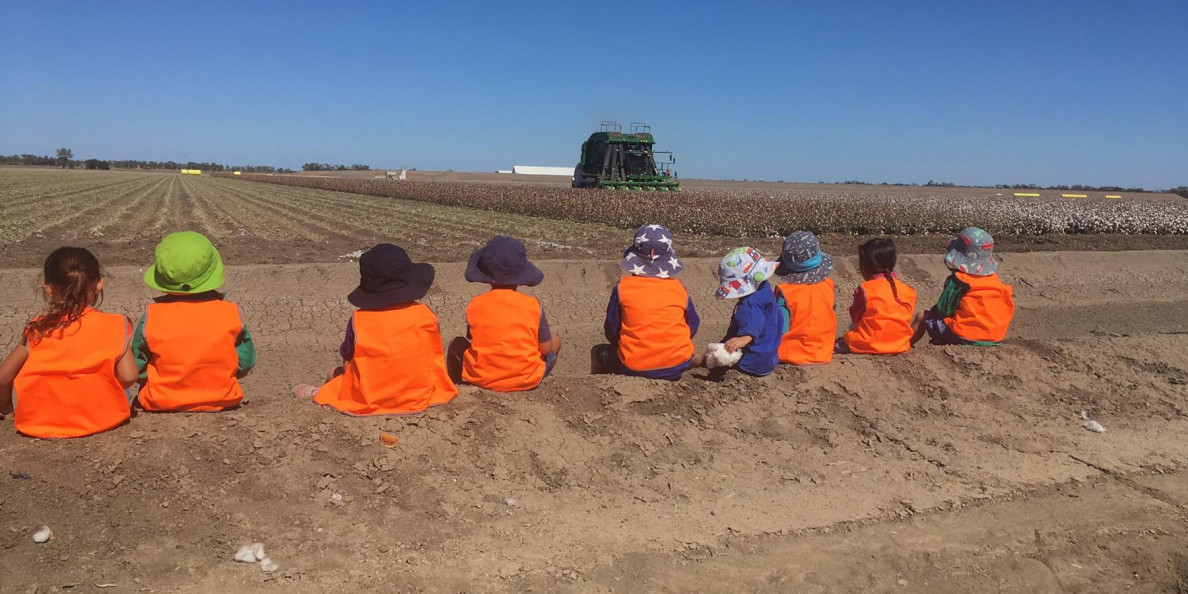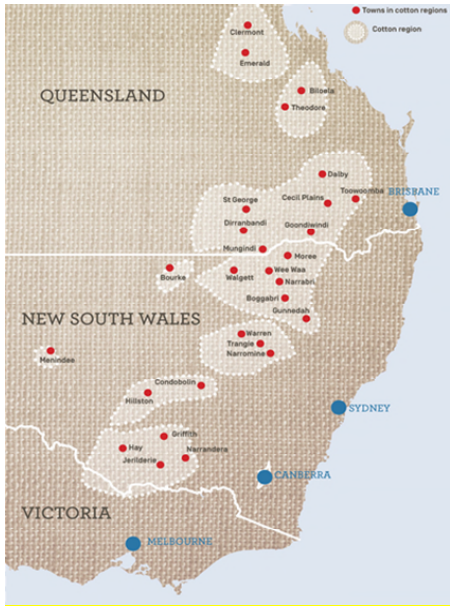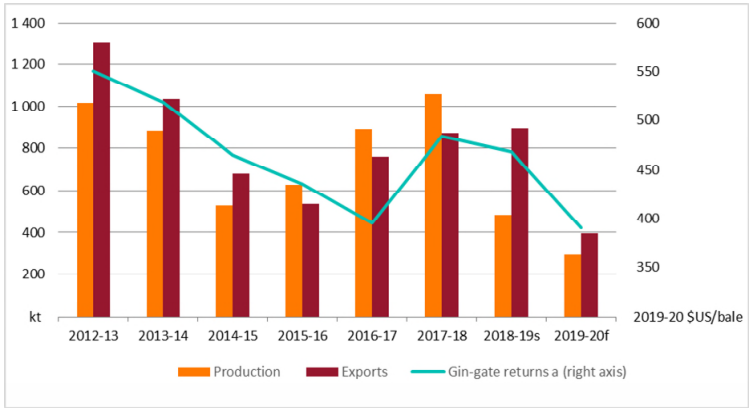Cotton production is one of the most important economic activities for many rural communities in eastern Australia. The number of cotton farms ranges from approximately 1200 to 1500 based on seasonal conditions, with around two thirds of the crop grown in New South Wales, and one third grown in Queensland (Figure 1). Through innovations in plant varieties and genetic modification, Australia’s cotton growing region is expanding into new locations such as Victoria and northern Australia, with these areas showing promise for further growth.
Despite being a relatively minor producer on a global scale, Australia is one of the world’s largest exporters of raw cotton, with almost 99 per cent exported annually.
Figure 1 Australia’s major cotton growing regions.
Outlook for cotton supply and demand
Australian cotton exports are forecast to exceed production in 2019-20, however there will be a significant reduction in both exports and production compared to previous years (Figure 2).
Forecast production in 2019-20
Cotton Australia estimates the production of Australian cotton lint to reach 170,000 tonnes for 2019-20. This represents a significant decrease from 2018-19 production levels, which can largely be attributed to a decline in cotton planting due to seasonal conditions. Cotton area is expected to cover 90,000 hectares in 2019-20, down from an estimated 343,000 hectares the previous season. This is due to significantly reduced water levels in the irrigation dams that serve cotton growing regions, and low soil moisture levels following extremely dry seasonal conditions. As at 23 October 2019, public irrigation dams serving Australia’s major cottongrowing regions averaged 19 per cent of capacity, roughly 15 per cent lower than at the same date in 2018. Due to insufficient rainfall prior to the 2019-20 growing season (November to February), Australian cotton production will unlikely reach 750,000 bales – the lowest level in over a decade.
Forecast exports in 2019-20
In 2019–20, the Australian Bureau of Agricultural and Resource Economics and Sciences (ABARES) forecast Australian cotton exports to reach approximately 397,000 tonnes despite the anticipated decline in production. Increased global production and high stock levels in 2019-20 are expected to reduce world cotton prices, contributing to a decline in the value of Australian cotton exports to around AUD$906 million (USD$6162 million) compared to previous years.
Forecast return to growers in 2019-20
In 2019–20, ABARES forecast the return to Australian cotton growers to average AUD$572 (USD$389) per bale (227 kilograms), representing a 12.5 per cent decline in returns from 2018-19.
Figure 2 Cotton production, exports and gin-gate returns, Australia, 2012-13 to 2019-20
a Value of lint and cottonseed, less ginning costs. f ABARES forecast3 . s ABARES estimate. (Source: ABARES, Agricultural Commodities September Quarter 2019)
1 Cotton Australia is the peak representative body for Australia’s cotton growing industry.
2 Based on currency conversion of AUD$1 being equivalent to USD$0.68 on 15 November 2019.
3 Cotton Australia estimate the 2019-20 values to be lower than what is depicted in the ABARES figure.
Issues facing the Australian cotton industry
Australian cotton production is dominated by irrigated cotton with only a small amount of dryland production. According to the Australian Bureau of Statistics (ABS), irrigated cotton production in 2017-18 accounted for a significant proportion of the water used on Australian farms, with increases in both area irrigated (359,000 hectares) and volume of water applied (2.8 million megalitres).
The most significant issues for the Australian cotton industry are the current drought and ongoing water reform.
Drought
Since March 2018, much of south-eastern, and large areas of western and northern Australia recorded rainfall totals in the lowest 5 to 10 per cent of the historical record. As a result of continued below average rainfall and above average temperatures, Australian cotton planting was limited in the 2019-20 season. According to ABARES, dam storage is down on average by 21 per cent in New South Wales cotton-growing regions and by 25 percent in Queensland cotton-growing regions and spring rainfall was insufficient to recharge dam levels or restore soil moisture.
Water Security – Murray-Darling Basin Plan
The Murray-Darling Basin (Basin) is one of the most important food and fibre regions in Australia, producing one-third of the national food supply and exporting produce to many other countries. In total, the Basin contains about 40 per cent of the nation’s irrigating agricultural businesses and accounts for roughly 91 per cent of Australia’s total cotton farms and cotton area.
The Australian Government’s water resource management focuses on national leadership and cooperation with state and territory governments. State and territory governments have the primary responsibility to regulate and manage Australian water resources. Local government also plays a crucial role in water management, particularly managing storm water, and in some instances water supply and waste water treatment.
The Basin Plan 2012 (Basin Plan) was agreed with bipartisan support in the Australian Parliament, and the support of Basin State and Territory Governments. The establishment of the Basin Plan followed several years of scientific, technical and socio economic analysis, and extensive consultation with the public and Basin Governments. The Basin Plan aims to return the Basin to a healthier and more sustainable level, while continuing to support strong regional communities and sustainable food and fibre production.
In 2017-18, 2.5 million megalitres of water was applied to 320,000 hectares of cotton plantings within the Murray-Darling Basin region. For irrigation purposes, most cotton growers in the Basin have what are classified “general, or low security” water licences, meaning that they only gain access to their share of water once the needs of towns, stock and domestic use, and the environment are met. Since 2017-18 cotton production has been constrained by low dam storage and soil moisture levels.
The Australian Government has committed AUD$13 billion (USD$8.8 billion) to water reform in the Murray-Darling Basin. More than 10,000 individual irrigators have benefitted from improvements to off-farm water delivery systems, and around 2,000 projects across the Basin have delivered improved returns from more efficient on-farm irrigation systems.
Labour and skills shortage
The Australian agriculture sector is currently experiencing a labour and skills shortage, driven by an aging workforce and low attraction rates. This is being felt in the cotton industry, which is facing the challenge of attracting and retaining core staff, on-farm labour (unskilled and skilled), and access to professional advisers and service providers. Remoteness of cotton farms also impedes recruitment.
Cotton challenges: finding smart and sustainable solutions
Role of the Public Sector in the cotton industry
The Australian Government and cotton producers co-invest in cotton research, development and extension (RD&E) through the Cotton Research and Development Corporation (CRDC) to deliver outcomes to benefit Australia’s dynamic cotton industry and the wider community.
CRDC is funded through a research and development levy, which all growers pay. The levy equates to AUD$2.25 (USD$1.53) for each 227 kilogram bale of cotton; or AUD$4.06 (USD$2.76) per tonne of exported seed cotton, with the Government matching levy funds dollar-for-dollar.
Improving water efficiencies in the cotton industry
Over the past 15 years, the Australian cotton industry has achieved a 40 per cent increase in water productivity. Improved water efficiencies have been achieved using a range of farming practices and development of new cotton varieties, as well as advances in water infrastructure and monitoring technologies.
Cotton farmers continue to employ techniques and technologies to improve their water use efficiency, such as soil moisture probes, sophisticated weather forecasting software ahead of planting, improving irrigation systems, shortening row lengths to reduce evaporation and applying mulching and stubble to help retain soil moisture.
The Australian cotton industry’s environmental management program – myBMP –includes a water management module covering water quality, efficiency of storage and distribution for both dryland and irrigated farming practices to improve farming practices and carefully manage natural resources.
Transfer of Technology
The cotton industry’s joint extension program, CottonInfo, plays an important role in transferring research and development knowledge to the industry. Formed in 2012 by CRDC, Cotton Australia and Cotton Seed Distributors Ltd, the extension program is designed to improve research and development communication, improve industry responsiveness, and improve industry practices.
Cotton to Market Strategy
The world’s leading brands and retailers are increasingly demanding fibres produced using more responsible and sustainable methods. Cotton Australia is involved in a number of cotton programs that promote and encourage responsible and sustainable cotton production and give Australian cotton a strong position in the world fibre market. These include the Better Cotton Initiative (BCI), the Cotton LEADS™ program, and the Australian Cotton Story.
myBMP is the Australian industry’s voluntary farm and environmental management system, and certification program that allows growers to identify regulatory requirements and compare their practices with best management practices and standards. The system has 10 key modules including Human Resources and Work Health and Safety; Water Management; and Soil Health.
Cotton Australia manages the industry’s relationship with BCI, a global sustainability program focused at farm level improvements. BCI directly aligns with myBMP certification standards. By opting into BCI, Australian growers have access to premium markets for cotton grown on myBMP certified farms. BCI presents an opportunity to leverage the Australian industry’s significant investment in sustainability.
The Cotton LEADS™ program, a partnership between the Australian and United States of America cotton industries, promotes the supply and use of responsibly-produced cotton through national and international efforts. In 2019, the number of Cotton LEADS™ partners rose to 573, of which 4 are Australian, with representation across brands, retailers and manufacturers from 33 countries around the world. Several iconic global brands are now including Cotton LEADS™ cotton as part of their sustainable sourcing strategies. Participation in this program through myBMP is giving Australian cotton access to these important markets.
Πηγή: ICAC Australia 2019



